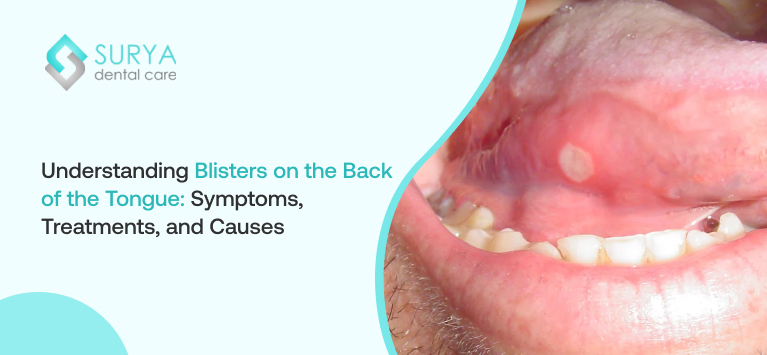Bumps on the tongue and side of the tongue are called fungiform papillae. They appear in the same color as the tongue and go unnoticeable. In some cases it can grow large which indicates the overall health of your body. If you notice any bump on the back of the tongue it can be a disturbing one often caused by oral infections and injuries. Any abnormality in this sensitive area can be uncomfortable and worrisome. Therefore, find out the symptoms, underlying causes and treatments for Blisters on the Back of the Tongue.
What is a Blister at the Back of the Tongue?
A blister at the back of the tongue is a fluid-filled sac that forms on the posterior part of the tongue. It can manifest as a white lesion or a canker sore which causes discomfort and soreness. These blisters may result from trauma, infections, immune system disorders, or nutritional deficiencies.
Symptoms
Some of the common symptoms of blisters at the back of the tongue include disturbance caused by the sensitive region of the tongue like.
- Change in food taste
- Disturbance during eating
- irritation during intake of acidic foods
- Disturbance during speaking
Back of Tongue Soreness
This is often the initial symptom experienced by individuals with blisters on the back of their tongues. The soreness can range from mild discomfort to sharp pain. Soreness on the back of the tongue is caused by injuries, intake of very hot and spicy foods and mouth ulcers.
White Blister on Back of Tongue
Oral thrush, canker sores and leukoplakia causes white blisters on the back of the tongue which is one of the symptoms you can notice when you have a bump on the back of the tongue. It manifests as a white or yellowish appearance due to the accumulation of pus or dead cells.
Canker Sore on Back of Tongue
Canker sores appear in the form of round or oval-shaped lesions with a white or yellow center and a red border in the back of the tongue . This symptom can be very painful during eating and speaking.
Treatment options for blister on the back of the tongue
- Topical Treatments: Temporary pain and discomfort alleviation can be obtained with over-the-counter topical ointments or gels that include chemicals like benzocaine or lidocaine. These products aid in blister healing by covering the blister with a barrier of protection.
- Oral Rinses: Mouthwashes with antiseptic properties or rinses with seawater can help lower inflammation and stop infections. Healing might be aided by rinsing multiple times a day with these treatments.
- Pain Relief Medications: Acetaminophen or ibuprofen, two nonsteroidal anti-inflammatory medicines (NSAIDs), can help to reduce discomfort and inflammation brought on by blisters on the back of the tongue.
- Avoiding Irritants: Foods with a rough texture, high acidity, or strong spices might irritate blisters and slow their healing. It is advised to stay away from these irritants while the blister heals.
- Hydration and Nutrition: It is possible to stop more discomfort and accelerate blister healing by eating a soft diet and drinking lots of water.
seven home remedies for bumps on the back of the tongue:
- Saltwater Rinse
One teaspoon of salt should be combined with a glass of warm water. After roughly 30 seconds of gargling with this solution, spit it out.Do this multiple times a day to aid in healing and inflammation reduction. Rinses with saltwater can also aid in bacterial destruction and illness prevention.
- Hydration
Staying hydrated promotes saliva production, which is necessary for maintaining oral hygiene and lessening tongue irritation. To keep your mouth moisturized sip lots of water throughout the day.
- Honey
Honey’s inherent antibacterial and anti-inflammatory qualities can help reduce inflammation and aid in the healing process. Therefore, directly apply a tiny bit of raw honey to the pimples on your tongue. Rinse your mouth with warm water after letting the honey remain on the pimples for a few minutes.
- Aloe Vera
Aloe Vera has calming and anti-inflammatory qualities which helps in reducing the discomfort and swelling brought on by tongue bumps.Directly apply the gel to your lumps on the back of the tongue.
- Cold Compress
For a few minutes, place a few ice cubes on the lumps on the back of your tongue by wrapping them in a clean cloth. The area can become numb and experience less discomfort and swelling due to the cool temperature. Avoid putting ice directly on the tongue as this may irritate it even more.
- Gentle Brushing
Brushing aids in the removal of bacteria and debris that can cause inflammation and infection.
Focus on the area of your tongue that has lumps and brush it softly with a toothbrush that has soft bristles. Refrain from brushing too firmly as this may aggravate the lumps.
- Avoid Irritants
Steer clear of meals that can irritate your tongue bumps, such as those that are hot, acidic or rough. Choose bland, soft foods that are easy to eat and won’t make the bumps worse. Stop the habit of using alcohol and tobacco products as these might exacerbate tongue irritation and stop the healing process.
Takeaway
Blisters on the back of the tongue typically don’t need to be taken seriously as these blisters usually go away on their own in a week or two with the right attention and care. However, it’s crucial to see a healthcare provider for additional assessment and treatment if the blisters continue to get bigger, or accompanied by any other serious symptoms.



